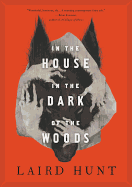
While Laird Hunt's In the House in the Dark of the Woods doesn't begin with the classic "once upon a time" lead-in of so many fairy tales, his protagonist's later account of her own story does: "Once upon a time there was and wasn't a woman who went into the woods...." And after she went into the New England woods, she lost her way and was rescued (or maybe captured) by Captain Jane, who took her to Eliza, who lived in a house by a lake (or maybe a swamp). The woman then tried to find her way home to her husband and son (or maybe she decided to stay).
As In the House in the Dark of the Woods unfolds, many things are left unclear: Did the colonial woman, whose eyes can "see through shadows," run away from home or simply lose her way? Are Jane and Eliza friends or foes? What is Goody not telling us about herself--and about her journey to and through the haunted woods? This ambiguity lends itself to the magical, mystical world Hunt (Neverhome) crafts as Goody sets forth to write her own story--both literally and figuratively--in a time and place that seem determined to let her do anything but. In the House in the Dark of the Woods is a tale of myths and magic, of subversion and upset, and of dark psychological suspense. It reads something like a fairy tale and something like a thriller--a haunting combination in more ways than one. --Kerry McHugh, blogger at Entomology of a Bookworm

